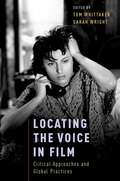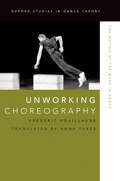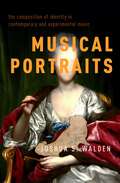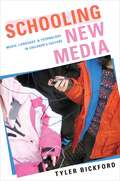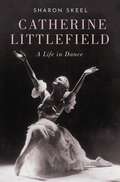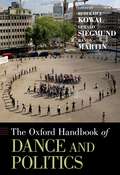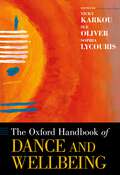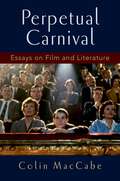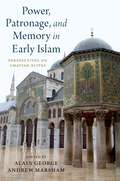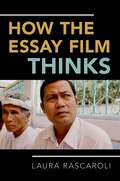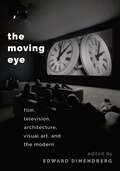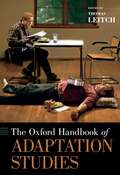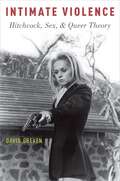- Table View
- List View
LOCATING THE VOICE IN FILM C: Critical Approaches and Global Practices
by Tom Whittaker and Sarah WrightWhere is the place of the voice in film? Where others have focused on Hollywood film, this volume aims to extend the field to other cinemas from around the world, encompassing Latin America, Asia and Africa amongst others. Traditional theoretical accounts, based on classical narrative cinema, examine the importance of the voice in terms of a desired perfect match between visuals and sonic effects. But, as the chapters of this volume illustrate, what is normative in one film industry may not apply in another. The widespread practices of dubbing, postsynch sound and "playback singing" in some countries, for instance, provide an alternative means of understanding the location of the voice in the soundtrack. Through seventeen original chapters, this volume situates the voice in film across a range of diverse national, transnational and cultural contexts, presenting readings which challenge traditional readings of the voice in film in exciting new ways. By taking a comparative view, this volume posits that the voice may be best understood as a mobile object, one whose trajectory follows a broader network of global flows. The various chapters explore the cultural transformations the voice undergoes as it moves from one industry to another. In doing so, the volume addresses sound practices which have been long been neglected, such as dubbing and non-synch sound, as well the ways in which sound technologies have shaped nationally specific styles of vocal performance. In addressing the place of the voice in film, the book intends to nuance existing theoretical writing on the voice while applying these critical insights in a global context.
The Image of Political Power in the Reign of Nerva, AD 96-98
by Nathan T. ElkinsAt age 65, Nerva assumed the role of emperor of Rome; just sixteen months later, his reign ended with his death. Nerva's short reign robbed his regime of the opportunity for the emperor's imperial image to be defined in building or monumental art, leaving seemingly little for the art historian or archaeologist to consider. In view of this paucity, studies of Nerva primarily focus on the historical circumstances governing his reign with respect to the few relevant literary sources. The Image of Political Power in the Reign of Nerva, AD 96-98, by contrast, takes the entire imperial coinage program issued by the mint of Rome to examine the "self-representation," and, by extension, the policies and ideals of Nerva's regime. The brevity of Nerva's reign and the problems of retrospection caused by privileging posthumous literary sources make coinage one of the only ways of reconstructing anything of his image and ideology as it was disseminated and developed at the end of the first century during the emperor's lifetime. The iconography of this coinage, and the popularity and spread of different iconographic types-as determined by study of hoards and finds, and as targeted towards different ancient constituencies-offers a more positive take on a little-studied emperor. Across three chapters, Elkins traces the different reverse types and how they would have resonated with their intended audiences, concluding with an examination of the parallels between text and coin iconography with previous and subsequent emperors. The Image of Political Power in the Reign of Nerva, AD 96-98 thus offers significant new perspectives on the agents behind the selection and formulation of iconography in the late first and early second century, showing how coinage can act as a visual panegyric similar to contemporary laudatory texts by tapping into how the inner circle of Nerva's regime wished the emperor to be seen.
The Image of Political Power in the Reign of Nerva, AD 96-98
by Nathan T. ElkinsAt age 65, Nerva assumed the role of emperor of Rome; just sixteen months later, his reign ended with his death. Nerva's short reign robbed his regime of the opportunity for the emperor's imperial image to be defined in building or monumental art, leaving seemingly little for the art historian or archaeologist to consider. In view of this paucity, studies of Nerva primarily focus on the historical circumstances governing his reign with respect to the few relevant literary sources. The Image of Political Power in the Reign of Nerva, AD 96-98, by contrast, takes the entire imperial coinage program issued by the mint of Rome to examine the "self-representation," and, by extension, the policies and ideals of Nerva's regime. The brevity of Nerva's reign and the problems of retrospection caused by privileging posthumous literary sources make coinage one of the only ways of reconstructing anything of his image and ideology as it was disseminated and developed at the end of the first century during the emperor's lifetime. The iconography of this coinage, and the popularity and spread of different iconographic types-as determined by study of hoards and finds, and as targeted towards different ancient constituencies-offers a more positive take on a little-studied emperor. Across three chapters, Elkins traces the different reverse types and how they would have resonated with their intended audiences, concluding with an examination of the parallels between text and coin iconography with previous and subsequent emperors. The Image of Political Power in the Reign of Nerva, AD 96-98 thus offers significant new perspectives on the agents behind the selection and formulation of iconography in the late first and early second century, showing how coinage can act as a visual panegyric similar to contemporary laudatory texts by tapping into how the inner circle of Nerva's regime wished the emperor to be seen.
UNWORKING CHOREOGRAPHY OSDT C: The Notion of the Work in Dance (Oxford Studies in Dance Theory)
by Frédéric PouillaudeThere is no archive or museum of human movement, no place where choreographies can be collected and conserved in pristine form. The central consequence of this is the incapacity of philosophy and aesthetics to think of dance as a positive and empirical art. In the eyes of philosophers, dance refers to a space other than art, considered both more frivolous and more fundamental than the artwork without ever quite attaining the status of a work. Unworking Choreography develops this idea and postulates an unworking as evidenced by a conspicuous absence of references to actual choreographic works within philosophical accounts of dance; the late development and partial dominance of the notion of the work in dance in contrast to other art forms such as painting, music, and theatre; the difficulties in identifying dance works given a lack of scores and an apparent resistance within the art form to the possibility of notation; and the questioning of ends of dance in contemporary practice and the relativisation of the very idea that dance artistic or choreographic processes aim at work production.
The Face on Film
by Noa SteimatskyThe human face was said to be rediscovered with the advent of motion pictures, in which it is often viewed as expressive locus, as figure, and even as essence of the cinema. But how has the modern, technological, mass-circulating art revealed the face in ways that are also distinct from any other medium? How has it altered our perception of this quintessential incarnation of the person? The archaic powers of masks and icons, the fashioning of the individual in the humanist portrait, the modernist anxieties of fragmentation and de-figuration--these are among the cultural precedents informing our experience in the movie theatre. Yet the moving image also offers radical new confrontations with the face: Dreyer's Passion of Joan of Arc, Donen's Funny Face, Hitchcock's The Wrong Man, Bresson's enigmatic Au hasard Balthazar, Antonioni's Screen Test, Warhol's filmic portraits of celebrity and anonymity are among the key works explored in this book. In different ways these intense encounters manifest a desire for transparency and plenitude, but--especially in post-classical cinema--they also betray a profound ambiguity that haunts the human countenance as it wavers between image and language, between what we see and what we know. The spectacular impact of the cinematic face is uncannily bound up with an opacity, a reticence. But is it not for this very reason that, like faces in the world, it still enthralls us?
Islamic Palace Architecture in the Western Mediterranean: A History
by Felix ArnoldPalaces like the Aljafería and the Alhambra rank among the highest achievements of the Islamic world. In recent years archaeological work at Córdoba, Kairouan and many other sites has vastly increased our knowledge about the origin and development of Islamic palatial architecture, particularly in the Western Mediterranean region. This book offers a comprehensive and up-to-date overview of Islamic palace architecture in Spain, Morocco, Algeria, Tunisia and southern Italy. The author, who has himself conducted archaeological field work at several prominent sites, presents all Islamic palaces known in the region in ground plans, sections and individual descriptions. The book traces the evolution of Islamic palace architecture in the region from the 8th to the 19th century and places them within the context of the history of Islamic culture. Palace architecture is a unique source of cultural history, offering insights into the way space was conceived and the way rulers used architecture to legitimize their power. The book discusses such topics as the influence of the architecture of the Middle East on the Islamic palaces of the western Mediterranean region, the role of Greek logic and scientific progress on the design of palaces, the impact of Islamic palaces on Norman and Gothic architecture and the role of Sufism on the palatial architecture of the late medieval period.
All That Jazz: The Life and Times of the Musical Chicago
by Ethan MorddenIn 1975, the Broadway musical Chicago brought together a host of memes and myths - the gleefully subversive character of American musical comedy, the reckless glamour of the big-city newspaper, the mad decade of the 1920s, the work of Bob Fosse and Gwen Verdon (two of the greatest talents in the musical's history), and the Wild West gangsterville that was the city of Chicago itself. The tale of a young woman who murders her departing lover and then tricks the jury into letting her off, Chicago seemed too blunt and cynical at first. Everyone agreed it was show biz at its brilliant best, yet the public still preferred A Chorus Line, with its cast of innocents and sentimental feeling. Nevertheless, the 1996 Chicago revival is now the longest-running American musical in history, and the movie version won the Best Picture Oscar. As author Ethan Mordden looks back at Chicago's various moving parts - including the original 1926 play that started it all, a sexy silent film directed by Cecil B. DeMille, a talkie remake with Ginger Rogers, the musical itself, and at last the movie of the musical - we see how the American theatre serves as a kind of alternative news medium, a town crier warning the public about the racy, devious interior contradictions of American society. Opinionated, witty, and rich in backstage anecdotes, All That Jazz brings the American Musical to life in all its artistry and excitement.
All That Jazz: The Life and Times of the Musical Chicago
by Ethan MorddenIn 1975, the Broadway musical Chicago brought together a host of memes and myths - the gleefully subversive character of American musical comedy, the reckless glamour of the big-city newspaper, the mad decade of the 1920s, the work of Bob Fosse and Gwen Verdon (two of the greatest talents in the musical's history), and the Wild West gangsterville that was the city of Chicago itself. The tale of a young woman who murders her departing lover and then tricks the jury into letting her off, Chicago seemed too blunt and cynical at first. Everyone agreed it was show biz at its brilliant best, yet the public still preferred A Chorus Line, with its cast of innocents and sentimental feeling. Nevertheless, the 1996 Chicago revival is now the longest-running American musical in history, and the movie version won the Best Picture Oscar. As author Ethan Mordden looks back at Chicago's various moving parts - including the original 1926 play that started it all, a sexy silent film directed by Cecil B. DeMille, a talkie remake with Ginger Rogers, the musical itself, and at last the movie of the musical - we see how the American theatre serves as a kind of alternative news medium, a town crier warning the public about the racy, devious interior contradictions of American society. Opinionated, witty, and rich in backstage anecdotes, All That Jazz brings the American Musical to life in all its artistry and excitement.
Musical Portraits: The Composition of Identity in Contemporary and Experimental Music
by Joshua S. WaldenJoshua S. Walden's Musical Portraits: The Composition of Identity in Contemporary and Experimental Music explores the wide-ranging but under-examined genre of musical portraiture. It focuses in particular on contemporary and experimental music created between 1945 and the present day, an era in which conceptions of identity have changed alongside increasing innovation in musical composition as well as in the uses of abstraction, mixed media, and other novel techniques in the field of visual portraiture. In the absence of physical likeness, an element typical of portraiture that cannot be depicted in sound, composers have experimented with methods of constructing other attributes of identity in music, such as character, biography, and profession. By studying musical portraits of painters, authors, and modern celebrities, in addition to composers' self-portraits, the book considers how representational and interpretive processes overlap and differ between music and other art forms, as well as how music is used in the depiction of human identities. Examining a range of musical portraits by composers including Peter Ablinger, Pierre Boulez, Morton Feldman, Philip Glass, György Ligeti, and Virgil Thomson, and director Robert Wilson's on-going series of video portraits of modern-day celebrities and his "portrait opera" Einstein on the Beach, Musical Portraits contributes to the study of music since 1945 through a detailed examination of contemporary understandings of music's capacity to depict identity, and of the intersections between music, literature, theater, film, and the visual arts.
Musical Portraits: The Composition of Identity in Contemporary and Experimental Music
by Joshua S. WaldenJoshua S. Walden's Musical Portraits: The Composition of Identity in Contemporary and Experimental Music explores the wide-ranging but under-examined genre of musical portraiture. It focuses in particular on contemporary and experimental music created between 1945 and the present day, an era in which conceptions of identity have changed alongside increasing innovation in musical composition as well as in the uses of abstraction, mixed media, and other novel techniques in the field of visual portraiture. In the absence of physical likeness, an element typical of portraiture that cannot be depicted in sound, composers have experimented with methods of constructing other attributes of identity in music, such as character, biography, and profession. By studying musical portraits of painters, authors, and modern celebrities, in addition to composers' self-portraits, the book considers how representational and interpretive processes overlap and differ between music and other art forms, as well as how music is used in the depiction of human identities. Examining a range of musical portraits by composers including Peter Ablinger, Pierre Boulez, Morton Feldman, Philip Glass, György Ligeti, and Virgil Thomson, and director Robert Wilson's on-going series of video portraits of modern-day celebrities and his "portrait opera" Einstein on the Beach, Musical Portraits contributes to the study of music since 1945 through a detailed examination of contemporary understandings of music's capacity to depict identity, and of the intersections between music, literature, theater, film, and the visual arts.
Schooling New Media: Music, Language, and Technology in Children's Culture
by Tyler BickfordPopular music and digital media are constantly entwined in elementary and middle-school children's talk, interactions, and relationships, and offer powerful cultural resources to children in their everyday struggles over institutionalized language, literacy, and expression in school. In Schooling New Media, author Tyler Bickford considers how digital music technologies are incorporated into children's expressive culture, their friendships, and their negotiations with adults about the place of language, music, and media in school. Schooling New Media is a groundbreaking study of children's music and media consumption practices, examining how transformations in music technologies influence the way children, their peers, and adults relate to one another. Based on long-term ethnographic research with a community of schoolchildren in Vermont, Bickford focuses on portable digital music devices - i.e. MP3 players - to reveal their key role in mediating intimate, face-to-face relationships and structuring children's interactions both with music and with each other. Schooling New Media provides an important ethnographic and theoretical intervention into ethnomusicology, childhood studies, and music education, emphasizing the importance-and yet under-appreciation-of interpersonal interactions and institutions like schools as sites of musical activity. Bickford explores how headphones facilitate these school-centered interactions, as groups of children share their earbuds with friends and listen to music together while participating in the dense overlap of talk, touch, and gesture of their peer groups. He argues that children treat MP3 players more like toys than technology, and that these devices expand the repertoires of childhood communicative practices such as passing notes and whispering-all means of interacting with friends beyond the reach of adults. These connections afforded by digital music listening enable children to directly challenge the language and literacy goals of classroom teachers. Bickford's Schooling New Media is unique in its intensive ethnographic attention to everyday sites of musical consumption and performance, and offers a sophisticated conceptual approach for understanding the problems and possibilities of children's uses of new media in schools.
Schooling New Media: Music, Language, and Technology in Children's Culture
by Tyler BickfordPopular music and digital media are constantly entwined in elementary and middle-school children's talk, interactions, and relationships, and offer powerful cultural resources to children in their everyday struggles over institutionalized language, literacy, and expression in school. In Schooling New Media, author Tyler Bickford considers how digital music technologies are incorporated into children's expressive culture, their friendships, and their negotiations with adults about the place of language, music, and media in school. Schooling New Media is a groundbreaking study of children's music and media consumption practices, examining how transformations in music technologies influence the way children, their peers, and adults relate to one another. Based on long-term ethnographic research with a community of schoolchildren in Vermont, Bickford focuses on portable digital music devices - i.e. MP3 players - to reveal their key role in mediating intimate, face-to-face relationships and structuring children's interactions both with music and with each other. Schooling New Media provides an important ethnographic and theoretical intervention into ethnomusicology, childhood studies, and music education, emphasizing the importance-and yet under-appreciation-of interpersonal interactions and institutions like schools as sites of musical activity. Bickford explores how headphones facilitate these school-centered interactions, as groups of children share their earbuds with friends and listen to music together while participating in the dense overlap of talk, touch, and gesture of their peer groups. He argues that children treat MP3 players more like toys than technology, and that these devices expand the repertoires of childhood communicative practices such as passing notes and whispering-all means of interacting with friends beyond the reach of adults. These connections afforded by digital music listening enable children to directly challenge the language and literacy goals of classroom teachers. Bickford's Schooling New Media is unique in its intensive ethnographic attention to everyday sites of musical consumption and performance, and offers a sophisticated conceptual approach for understanding the problems and possibilities of children's uses of new media in schools.
Catherine Littlefield: A Life in Dance
by Sharon SkeelWhile she is best remembered today as founder of the Philadelphia Ballet and the director and driving force behind the famous Littlefield School of Ballet, from which Balanchine drew the nucleus for his School of American Ballet, Catherine Littlefield (1905-51) and her oeuvre were in many ways emblematic of the full representation of dance throughout entertainments of the first half of the 20th century. From her early work as a teenager dancing for Florenz Ziegfeld to her later work in choreographing extravagant ice skating shows, a remarkable dance with 90 bicyclists for the 1940 World's Fair, and on television as resident choreographer for The Jimmy Durante Show, Littlefield was amongst the first choreographers to bring concert dance to broader venues, and her legacy lives on today in her enduring influence on generations of American ballet dancers. As the first biography of Littlefield, Catherine Littlefield: A Life in Dance traces her life in full from birth through childhood experiences dancing on the Academy of Music's grand stage, and from her foundation of the groundbreaking Philadelphia Ballet Company in 1935 to her later work in television and beyond. Littlefield counted among her many glamorous friends and colleagues writer Zelda Fitzgerald, conductor Leopold Stokowski, and composer Kurt Weill. This biography also provides an engrossing portrait of the remarkable Littlefield family, many of whom were instrumental to Catherine's success. With the unflagging support of her generous husband and indomitable mother, Littlefield gave shape to the course of American ballet in the 20th century long before Balanchine arrived in the United States.
Catherine Littlefield: A Life in Dance
by Sharon SkeelWhile she is best remembered today as founder of the Philadelphia Ballet and the director and driving force behind the famous Littlefield School of Ballet, from which Balanchine drew the nucleus for his School of American Ballet, Catherine Littlefield (1905-51) and her oeuvre were in many ways emblematic of the full representation of dance throughout entertainments of the first half of the 20th century. From her early work as a teenager dancing for Florenz Ziegfeld to her later work in choreographing extravagant ice skating shows, a remarkable dance with 90 bicyclists for the 1940 World's Fair, and on television as resident choreographer for The Jimmy Durante Show, Littlefield was amongst the first choreographers to bring concert dance to broader venues, and her legacy lives on today in her enduring influence on generations of American ballet dancers. As the first biography of Littlefield, Catherine Littlefield: A Life in Dance traces her life in full from birth through childhood experiences dancing on the Academy of Music's grand stage, and from her foundation of the groundbreaking Philadelphia Ballet Company in 1935 to her later work in television and beyond. Littlefield counted among her many glamorous friends and colleagues writer Zelda Fitzgerald, conductor Leopold Stokowski, and composer Kurt Weill. This biography also provides an engrossing portrait of the remarkable Littlefield family, many of whom were instrumental to Catherine's success. With the unflagging support of her generous husband and indomitable mother, Littlefield gave shape to the course of American ballet in the 20th century long before Balanchine arrived in the United States.
The Oxford Handbook of Dance and Politics (Oxford Handbooks)
by Rebekah J. Kowal, Gerald Siegmund and Randy MartinIn recent decades, dance has become a vehicle for querying assumptions about what it means to be embodied, in turn illuminating intersections among the political, the social, the aesthetical, and the phenomenological. The Oxford Handbook of Dance and Politics edited by internationally lauded scholars Rebekah Kowal, Gerald Siegmund, and the late Randy Martin presents a compendium of newly-commissioned chapters that address the interdisciplinary and global scope of dance theory - its political philosophy, social movements, and approaches to bodily difference such as disability, postcolonial, and critical race and queer studies. In six sections 30 of the most prestigious dance scholars in the US and Europe track the political economy of dance and analyze the political dimensions of choreography, of writing history, and of embodied phenomena in general. Employing years of intimate knowledge of dance and its cultural phenomenology, scholars urge readers to re-think dominant cultural codes, their usages, and the meaning they produce and theorize ways dance may help to re-signify and to re-negotiate established cultural practices and their inherent power relations. This handbook poses ever-present questions about dance politics-which aspects or effects of a dance can be considered political? What possibilities and understandings of politics are disclosed through dance? How does a particular dance articulate or undermine forces of authority? How might dance relate to emancipation or bondage of the body? Where and how can dance articulate social movements, represent or challenge political institutions, or offer insight into habits of labor and leisure? The handbook opens its critical terms in two directions. First, it offers an elaborated understanding of how dance achieves its politics. Second, it illustrates how notions of the political are themselves expanded when viewed from the perspective of dance, thus addressing both the relationship between the politics in dance and the politics of dance. Using the most sophisticated theoretical frameworks and engaging with the problematics that come from philosophy, social science, history, and the humanities, chapters explore the affinities, affiliations, concepts, and critiques that are inherent in the act of dance, and questions about matters political that dance makes legible.
The Oxford Handbook of Dance and Wellbeing (Oxford Handbooks)
by Vicky Karkou, Sue Oliver and Sophia LycourisIn recent years, a growth in dance and wellbeing scholarship has resulted in new ways of thinking that place the body, movement, and dance in a central place with renewed significance for wellbeing. The Oxford Handbook of Dance and Wellbeing examines dance and related movement practices from the perspectives of neuroscience and health, community and education, and psychology and sociology to contribute towards an understanding of wellbeing, offer new insights into existing practices, and create a space where sufficient exchange is enabled. The handbook's research components include quantitative, qualitative, and arts-based research, covering diverse discourses, methodologies, and perspectives that add to the development of a complete picture of the topic. Throughout the handbook's wide-ranging chapters, the objective observations, felt experiences, and artistic explorations of practitioners interact with and are printed alongside academic chapters to establish an egalitarian and impactful exchange of ideas.
Perpetual Carnival: Essays on Film and Literature
by Colin MacCabeUpholding literature and film together as academically interwoven, Perpetual Carnival underscores the everlasting coexistence of realism and modernism, eschewing the popularly accepted view that the latter is itself a rejection of the former. Mining examples from both film and literature, Colin MacCabe asserts that the relationship between film and literature springs to life a wealth of beloved modernist art, from Jean-Luc Godard's Pierre le Fou to James Joyce's Ulysses, enriched by realism's enduring legacy. The intertextuality inherent in adaptation furthers this assertion in MacCabe's inclusion of Roman Polanski's Tess, a 1979 adaptation of Thomas Hardy's nineteenth-century realist novel, Tess of the d'Urbervilles. Showcasing essays enlivened by cosmopolitan interests, theoretical insight, and strong social purpose, Perpetual Carnival supports a humanities which repudiates narrow specialization and which seeks to place the discussion of film and literature firmly in the reality of current political and ideological discussion. It argues for the writers and directors, the thinkers and critics, who have most fired the contemporary imagination.
Power, Patronage, and Memory in Early Islam: Perspectives on Umayyad Elites
by Alain George and Andrew MarshamWhen the Umayyads, the first Islamic dynasty, rose to power shortly after the death of the Prophet Muhammad (d. 632), the polity of which they assumed control had only recently expanded out of Arabia into the Roman eastern Mediterranean, Iraq and Iran. A century later, by the time of their downfall in 750, the last Umayyad caliphs governed the largest empire that the world had seen, stretching from Spain in the West to the Indus valley and Central Asia in the East. By then, their dynasty and the ruling circles around it had articulated with increasing clarity the public face of the new monotheistic religion of Islam, created major masterpieces of world art and architecture, some of which still stand today, and built a state apparatus that was crucial to ensuring the continuity of the Islamic polity. Within the vast lands under their control, the Umayyads and their allies ruled over a mosaic of peoples, languages and faiths, first among them Christianity, Judaism and the Ancient religion of Iran, Zoroastrianism. The Umayyad period is profoundly different from ours, yet it also resonates with modern concerns, from the origins of Islam to dynamics of cultural exchange. Editors Alain George and Andrew Marsham bring together a collection of essays that shed new light on this crucial period. Power, Patronage, and Memory in Early Islam elucidates the ways in which Umayyad élites fashioned and projected their self-image, and how these articulations, in turn, mirrored their own times. The authors, combining perspectives from different disciplines, present new material evidence, introduce fresh perspectives about key themes and monuments, and revisit the nature of the historical writing that shaped our knowledge of this period.
How the Essay Film Thinks
by Laura RascaroliThis book offers a novel understanding of the epistemological strategies that are mobilized by the essay film, and of where and how such strategies operate. Against the backdrop of Adorno's discussion of the essay form's anachronistic, anti-systematic and disjunctive mode of resistance, and capitalizing on the centrality of the interstice in Deleuze's understanding of the cinema as image of thought, the book discusses the essay film as future philosophy-as a contrarian, political cinema whose argumentation engages with us in a space beyond the verbal. A diverse range of case studies discloses how the essay film can be a medium of thought on the basis of its dialectic use of audiovisual interstitiality. The book shows how the essay film's disjunctive method comes to be realized at the level of medium, montage, genre, temporality, sound, narration, and framing-all of these emerging as interstitial spaces of intelligence that illustrate how essayistic meaning can be sustained, often in contexts of political, historical or cultural extremity. The essayistic urge is not to be identified with a fixed generic form, but is rather situated within processes of filmic thinking that thrive in gaps.
MOVING EYE C: Film, Television, Architecture, Visual Art and the Modern
by Edward DimendbergOnce the province of film and media scholars, today the moving image is of broad concern to historians of art and architecture and designers of everything from websites to cities. As museums and galleries devote increasing space to video installations which no longer presuppose a fixed viewer, urban space becomes envisioned and planned through "fly throughs," and technologies such as GPS add data to the experience of travel, moving images have captured the attention of geographers and scholars across the humanities and social sciences. Their practice of "mobility studies" is remaking how we understand a contemporary world in relentless motion. Media theorist and historian Anne Friedberg (1952-2009) was among the first practitioners of visual studies to theorize the experience of vision in motion. Her books have become key points of reference in the discussion of the windows that frame images and the viewers in motion who perceive them. Although widely influential beyond her own discipline, Friedberg's work has never been the subject of an extended study. The Moving Eye: Film, Television, Architecture, Visual Art and the Modern gathers together essays by renowned thinkers in media studies, art history, architecture, and museum studies to consider the rich implications of her work for understanding film and video, new media, visual art, architecture, exhibition design, urban space, and virtual reality. Ranging from early cinema, to works by Le Corbusier, Sergei Eisenstein, Gordon Matta-Clark, and Pierre Huyghe, to theories of the image in motion informed by psychoanalysis, theories of the public sphere, and animal studies, each of the nine essays in the book advances the lines of inquiry commenced by Friedberg.
The Oxford Handbook of Adaptation Studies (Oxford Handbooks)
by Thomas LeitchThis collection of forty new essays, written by the leading scholars in adaptation studies and distinguished contributors from outside the field, is the most comprehensive volume on adaptation ever published. Written to appeal alike to specialists in adaptation, scholars in allied fields, and general readers, it hearkens back to the foundations of adaptation studies a century and more ago, surveys its ferment of activity over the past twenty years, and looks forward to the future. It considers the very different problems in adapting the classics, from the Bible to Frankenstein to Philip Roth, and the commons, from online mashups and remixes to adult movies. It surveys a dizzying range of adaptations around the world, from Latin American telenovelas to Czech cinema, from Hong Kong comics to Classics Illustrated, from Bollywood to zombies, and explores the ways media as different as radio, opera, popular song, and videogames have handled adaptation. Going still further, it examines the relations between adaptation and such intertextual practices as translation, illustration, prequels, sequels, remakes, intermediality, and transmediality. The volume's contributors consider the similarities and differences between adaptation and history, adaptation and performance, adaptation and revision, and textual and biological adaptation, casting an appreciative but critical eye on the theory and practice of adaptation scholars--and, occasionally, each other. The Oxford Handbook of Adaptation Studies offers specific suggestions for how to read, teach, create, and write about adaptations in order to prepare for a world in which adaptation, already ubiquitous, is likely to become ever more important.
William Faulkner at Twentieth Century-Fox: The Annotated Screenplays
by Sarah Gleeson-WhiteWilliam Faulkner at Twentieth Century-Fox: The Annotated Screenplays presents for the first time and in one volume the five screenplays Faulkner wrote while under contract to Twentieth Century-Fox in the mid 1930s and a sixth he wrote in 1952. An informative introduction describes Faulkner's screenwriting practices, such as adaptation and collaboration, and contextualizes these within a broader genealogy of Hollywood screenwriting and within one of the most important moments in the history of American cinema. Each of the six screenplays appears in full with scholarly annotations, and brief prefatory essays elucidate their evolution over various drafts and with various co-writers. The edition makes available for the first time and in one volume Faulkner's Fox screen writings, and, with its scholarly apparatus, thus makes a valuable contribution to recent scholarship across a number of fields: Faulkner and film; literature and film/adaptation studies; cinematic modernism; and screenplay studies. It also foregrounds Faulkner's many significant collaborators, such as Zanuck and Howard Hawks, and therefore makes an important contribution to the history of Twentieth Century-Fox under Zanuck.
The Economics of American Art: Issues, Artists and Market Institutions
by Robert B. Ekelund Jr. John D. Jackson Robert D. TollisonThe rapidly changing and evolving art market might appear to be chaotic to the casual observer, with new highs, potential lows, and tastes and fashions changing season to season. Economists, however, view the actions of buyers and sellers as constituting an identifiable market. They have, for some decades, studied such issues as artistic productivity and "death effects" on prices, investment returns, and on the basis of the behavior and estimated prices in auction markets. The Economics of American Art analyzes the most pervasive economic issues facing the art world, applied to the whole spectrum of American art. The book begins by looking at how a market for American art developed, how the politics of the post-war era shaped, at least in large part, the direction of American art, and how this legacy continues into contemporary art today. The book then tackles several salient, integral questions animating the American art world: Are age and "type" of artist (i.e. traditional or "innovative") related and, if so, how might they be related to productivity? Is investment in American art a remunerative endeavor compared to other investment possibilities? Do economic insights provide understanding of fakes, fraud and theft of art, particularly American art, and is it possible to prevent art crime? Is there is a boom (or a bust) in the market for contemporary American art as might be found in other markets? The ongoing evolution of American art is attended by a massive number of influences, and the economic concepts employed in this volume will complement other critical and important cultural studies of art. Both practical and accessible, The Economics of American Art will be essential for collectors, auction houses, American art experts of all kinds, museums, gallery owners and, not least, by economists with continuing scholarly interests in these matters.
The Economics of American Art: Issues, Artists and Market Institutions
by John D. Jackson Robert D. Tollison Robert B. Ekelund Jr.The rapidly changing and evolving art market might appear to be chaotic to the casual observer, with new highs, potential lows, and tastes and fashions changing season to season. Economists, however, view the actions of buyers and sellers as constituting an identifiable market. They have, for some decades, studied such issues as artistic productivity and "death effects" on prices, investment returns, and on the basis of the behavior and estimated prices in auction markets. The Economics of American Art analyzes the most pervasive economic issues facing the art world, applied to the whole spectrum of American art. The book begins by looking at how a market for American art developed, how the politics of the post-war era shaped, at least in large part, the direction of American art, and how this legacy continues into contemporary art today. The book then tackles several salient, integral questions animating the American art world: Are age and "type" of artist (i.e. traditional or "innovative") related and, if so, how might they be related to productivity? Is investment in American art a remunerative endeavor compared to other investment possibilities? Do economic insights provide understanding of fakes, fraud and theft of art, particularly American art, and is it possible to prevent art crime? Is there is a boom (or a bust) in the market for contemporary American art as might be found in other markets? The ongoing evolution of American art is attended by a massive number of influences, and the economic concepts employed in this volume will complement other critical and important cultural studies of art. Both practical and accessible, The Economics of American Art will be essential for collectors, auction houses, American art experts of all kinds, museums, gallery owners and, not least, by economists with continuing scholarly interests in these matters.
INTIMATE VIOLENCE C: Hitchcock, Sex, and Queer Theory
by David GrevenIntimate Violence explores the consistent cold war in Hitchcock's films between his heterosexual heroines and his queer characters, usually though not always male. Decentering the authority of the male hero, Hitchcock's films allow his female and queer characters to vie for narrative power, often in conflict with one another. These conflicts eerily echo the tense standoff between feminism and queer theory. From a reparative psychoanalytic perspective, David Greven merges queer and feminist approaches to Hitchcock. Using the theories of Melanie Klein, Greven argues that Hitchcock's work thematizes a constant battle between desires to injure and to repair the loved object. Greven develops a theory of sexual hegemony. The feminine versus the queer conflict, as he calls it, in Hitchcock films illuminates the shared but rivalrous struggles for autonomy and visibility on the part of female and queer subjects. The heroine is vulnerable to misogyny, but she often gains an access to agency that the queer subject longs for, mistaking her partial autonomy for social power. Hitchcock's queer personae, however, wield a seductive power over his heterosexual subjects, having access to illusion and masquerade that the knowledge-seeking heroine must destroy. Freud's theory of paranoia, understood as a tool for the dissection of cultural homophobia, illuminates the feminine versus the queer conflict, the female subject position, and the consistent forms of homoerotic antagonism in the Hitchcock film. Through close readings of such key Hitchcock works as North by Northwest, Psycho, Strangers on a Train, Spellbound, Rope, Marnie, and The Birds, Greven explores the ongoing conflicts between the heroine and queer subjects and the simultaneous allure and horror of same-sex relationships in the director's films.
